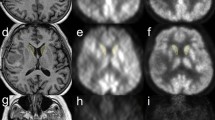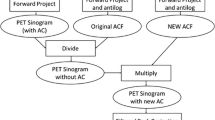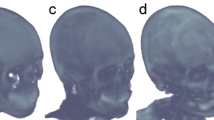Abstract
Objective
A mobile PET scanner termed flexible PET (fxPET) has been designed to fit existing MRI systems. The purpose of this study was to assess brain imaging with fxPET combined with 3-T MRI in comparison with conventional PET (cPET)/CT.
Methods
In this prospective study, 29 subjects with no visible lesions except for mild leukoaraiosis on whole brain imaging underwent 2-deoxy-2-[18F]fluoro-D-glucose ([18F]FDG) cPET/CT followed by fxPET and MRI. The registration differences between fxPET and MRI and between cPET and CT were compared by measuring spatial coordinates. Three-dimensional magnetization-prepared rapid acquisition gradient-echo T1-weighted imaging (T1WI) was acquired. We applied two methods of attenuation correction to the fxPET images: MR-based attenuation correction, which yielded fxPETMRAC; and CT-based attenuation correction, which yielded fxPETCTAC. The three PET datasets were co-registered to the T1WI. Following subcortical segmentation and cortical parcellation, volumes of interest were placed in each PET image to assess physiological accumulation in the brain. SUVmean was obtained and compared between the three datasets. We also visually evaluated image distortion and clarity of fxPETMRAC.
Results
Mean misregistration of fxPET/MRI was < 3 mm for each margin. Mean registration differences were significantly larger for fxPET/MRI than for cPET/CT except for the superior margin. There were high correlations between the three PET datasets regarding SUVmean. On visual evaluation of image quality, the grade of distortion was comparable between fxPETMRAC and cPET, and the grade of clarity was acceptable but inferior for fxPETMRAC compared with cPET.
Conclusions
fxPET could successfully determine physiological [18F]FDG uptake; however, improved image clarity is desirable. In this study, fxPET/MRI at 3-T was feasible for brain imaging.





Similar content being viewed by others
Data availability statement
The data that support the findings of this study are available from the corresponding author upon reasonable request.
References
Bar-Shalom R, Yefremov N, Guralnik L, Gaitini D, Frenkel A, Kuten A, et al. Clinical performance of PET/CT in evaluation of cancer: additional value for diagnostic imaging and patient management. J Nucl Med. 2003;44:1200–9.
Antoch G, Saoudi N, Kuehl H, Dahmen G, Mueller SP, Beyer T, et al. Accuracy of whole-body dual-modality fluorine-18-2-fluoro-2-deoxy-D-glucose positron emission tomography and computed tomography (FDG-PET/CT) for tumor staging in solid tumors: comparison with CT and PET. J Clin Oncol. 2004;22:4357–68.
Bailey DL, Pichler BJ, Gückel B, Antoch G, Barthel H, Bhujwalla ZM, et al. Combined PET/MRI: global warming-summary report of the 6th international workshop on PET/MRI, March 27–29, 2017, Tübingen, Germany. Mol Imaging Biol. 2018;20:4–20.
Broski SM, Goenka AH, Kemp BJ, Johnson GB. Clinical PET/MRI: 2018 update. AJR Am J Roentgenol. 2018;211:295–313.
Hope TA, Fayad ZA, Fowler KJ, Holley D, Iagaru A, McMillan AB, et al. Summary of the first ISMRM-SNMMI workshop on PET/MRI: applications and limitations. J Nucl Med. 2019;60:1340–6.
Drzezga A, Souvatzoglou M, Eiber M, Beer AJ, Fürst S, Martinez-Möller A, et al. First clinical experience with integrated whole-body PET/MR: comparison to PET/CT in patients with oncologic diagnoses. J Nucl Med. 2012;53:845–55.
Catana C, Drzezga A, Heiss WD, Rosen BR. PET/MRI for neurologic applications. J Nucl Med. 2012;53:1916–25.
Kishi S, Maeda M, Kogue R, Umino M, Matsubara T, Sakuma H. Hemangioblastoma of the cerebellopontine angle evaluated with pseudocontinuous arterial spin labeling. Magn Reson Med Sci. 2021;20:18–9.
Imaizumi A, Obata T, Kershaw J, Tachibana Y, Inubushi M, Koizumi M, et al. Imaging of hypoxic tumor: correlation between diffusion-weighted MR imaging and (18)F-fluoroazomycin arabinoside positron emission tomography in head and neck carcinoma. Magn Reson Med Sci. 2020;19:276–81.
Chen KT, Salcedo S, Chonde DB, Izquierdo-Garcia D, Levine MA, Price JC, et al. MR-assisted PET motion correction in simultaneous PET/MRI studies of dementia subjects. J Magn Reson Imaging. 2018;48:1288–96.
Chawla SC, Federman N, Zhang D, Nagata K, Nuthakki S, McNitt-Gray M, et al. Estimated cumulative radiation dose from PET/CT in children with malignancies: a 5-year retrospective review. Pediatr Radiol. 2010;40:681–6.
Varoquaux A, Rager O, Poncet A, Delattre BM, Ratib O, Becker CD, et al. Detection and quantification of focal uptake in head and neck tumours: (18)F-FDG PET/MR versus PET/CT. Eur J Nucl Med Mol Imaging. 2014;41:462–75.
Zeng T, Zheng J, Xia X, Chen X, Wang B, Zhang S, et al. Design and system evaluation of a dual-panel portable PET (DP-PET). EJNMMI Phys. 2021;8:47.
Nakamoto R, Nakamoto Y, Ishimori T, Fushimi Y, Kido A, Togashi K. Comparison of PET/CT with sequential PET/MRI Using an MR-compatible mobile PET system. J Nucl Med. 2018;59:846–51.
Suzuki M, Fushimi Y, Okada T, Hinoda T, Nakamoto R, Arakawa Y, et al. Quantitative and qualitative evaluation of sequential PET/MRI using a newly developed mobile PET system for brain imaging. Jpn J Radiol. 2021;39:669–80.
Watanabe M, Kawai-Miyake K, Fushimi Y, Ishimori T, Nakajima A, Yoshimura M, et al. Application of a flexible PET scanner combined with 3 T MRI using non-local means reconstruction: qualitative and quantitative comparison with whole-body PET/CT. Mol Imaging Biol. 2022;24:167–76.
Yamakawa Y, Kobayashi T, Furuta M, Sato M, Ohi J, Tonami H, et al. Development of a dual-head mobile DOI-TOF PET system having multi-modality compatibility. 2014 IEEE Nucl Sci Symp Med Imag Conf. Seattle, WA, USA; 2014. p. 1-3. https://doi.org/10.1109/NSSMIC.2014.7430879
Furumiya T, Tsuda T, Tonami H, Satoh M, Nakazawa M, Ohi J, et al. Development of a SiPM based MR-compatible DOI-TOF-PET detector. 2014 IEEE Nucl Sci Symp Med Imag Conf. Seattle, WA, USA; 2014. p. 1-3. doi:https://doi.org/10.1109/NSSMIC.2014.7430888
Hong KJ, Choi Y, Jung JH, Kang J, Hu W, Lim HK, et al. A prototype MR insertable brain PET using tileable GAPD arrays. Med Phys. 2013;40: 042503.
Watanabe M, Nakamoto Y, Nakamoto R, Ishimori T, Saga T, Togashi K. Performance evaluation of a newly developed MR-compatible mobile PET scanner with two detector layouts. Mol Imaging Biol. 2020;22:407–15.
Reynés-Llompart G, Gámez-Cenzano C, Romero-Zayas I, Rodríguez-Bel L, Vercher-Conejero JL, Martí-Climent JM. Performance characteristics of the whole-body discovery IQ PET/CT system. J Nucl Med. 2017;58:1155–61.
Wagatsuma K, Miwa K, Sakata M, Oda K, Ono H, Kameyama M, et al. Comparison between new-generation SiPM-based and conventional PMT-based TOF-PET/CT. Phys Med. 2017;42:203–10.
Watanabe M, Nakamoto Y, Nakamoto R, Ishimori T, Saga T, Togashi K. Qualitative and quantitative assessment of nonlocal means reconstruction algorithm in a flexible PET scanner. AJR Am J Roentgenol. 2021;216:486–93.
Tanigawa A, Yamaya T, Kawaguchi H, Hirano Y, Shiraishi T, Tanimoto K, et al. Hybrid segmentation-atlas method for PET-MRI attenuation correction. 2012 IEEE Nucl Sci Symp Med Imag Conf. Anaheim, CA, USA; 2012. p. 2727-9. https://doi.org/10.1109/NSSMIC.2012.6551620
Otsu N. A threshold selection method from gray-level histograms. IEEE Trans Syst Man Cybern Syst. 1979;9:62–6.
Burger C, Goerres G, Schoenes S, Buck A, Lonn AH, Von Schulthess GK. PET attenuation coefficients from CT images: experimental evaluation of the transformation of CT into PET 511-keV attenuation coefficients. Eur J Nucl Med Mol Imaging. 2002;29:922–7.
Maes F, Collignon A, Vandermeulen D, Marchal G, Suetens P. Multimodality image registration by maximization of mutual information. IEEE Trans Med Imaging. 1997;16:187–98.
Brendle CB, Schmidt H, Fleischer S, Braeuning UH, Pfannenberg CA, Schwenzer NF. Simultaneously acquired MR/PET images compared with sequential MR/PET and PET/CT: alignment quality. Radiology. 2013;268:190–9.
Eiber M, Martinez-Möller A, Souvatzoglou M, Holzapfel K, Pickhard A, Löffelbein D, et al. Value of a dixon-based MR/PET attenuation correction sequence for the localization and evaluation of PET-positive lesions. Eur J Nucl Med Mol Imaging. 2011;38:1691–701.
Conti M. Focus on time-of-flight PET: the benefits of improved time resolution. Eur J Nucl Med Mol Imaging. 2011;38:1147–57.
Nakazawa M, Ohi J, Tonami H, Yamada Y, Furumiya T, Furuta M, et al. Development of a prototype DOI-TOF-PET scanner. 2010 IEEE Nucl Sci Symp Med Imag Conf. Knoxville, TN, USA; 2010. p. 2077-80. https://doi.org/10.1109/NSSMIC.2010.5874142
Soret M, Bacharach SL, Buvat I. Partial-volume effect in PET tumor imaging. J Nucl Med. 2007;48:932–45.
Ishii K, Sakamoto S, Hosaka K, Mori T, Sasaki M. Variation in FDG uptakes in different regions in normal human brain as a function of the time (30 and 60 minutes) after injection of FDG. Ann Nucl Med. 2002;16:299–301.
Ishii K, Higashi Y, Tabata M, Miyaishi M, Mizutani T, Sasaki M. Necessity of a uniform start for scanning after FDG injection in brain PET study. Ann Nucl Med. 2006;20:329–31.
Acknowledgements
We are grateful to Tetsuya Kobayashi, Junichi Ohi, and Keishi Kitamura from Shimadzu Corporation for their technical advice. We also thank Taisuke Nagao, Masaaki Kajisako, and Shigeto Kawase for their technical support.
Funding
This work was supported by JSPS KAKENHI Grant No. 22K07746, 21K15826, 21K20834, and 21K15623.
Author information
Authors and Affiliations
Corresponding author
Ethics declarations
Conflict of interest
Yuji Nakamoto obtained financial support from Shimadzu Corporation, Kyoto, Japan. This prototype mobile PET scanner was developed by the company and was provided free of charge for use in this study. The other authors have no conflicts of interest directly relevant to the content of this article.
Additional information
Publisher's Note
Springer Nature remains neutral with regard to jurisdictional claims in published maps and institutional affiliations.
Supplementary Information
Below is the link to the electronic supplementary material.
Rights and permissions
Springer Nature or its licensor (e.g. a society or other partner) holds exclusive rights to this article under a publishing agreement with the author(s) or other rightsholder(s); author self-archiving of the accepted manuscript version of this article is solely governed by the terms of such publishing agreement and applicable law.
About this article
Cite this article
Nakajima, S., Fushimi, Y., Hinoda, T. et al. Brain imaging of sequential acquisition using a flexible PET scanner and 3-T MRI: quantitative and qualitative assessment. Ann Nucl Med 37, 209–218 (2023). https://doi.org/10.1007/s12149-022-01817-6
Received:
Accepted:
Published:
Issue Date:
DOI: https://doi.org/10.1007/s12149-022-01817-6




